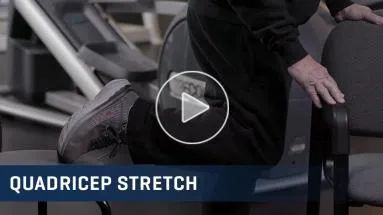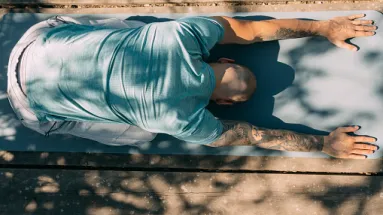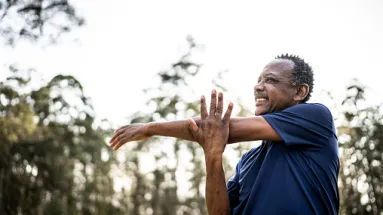Staying active indoors: Five tips to keep moving
Staying active indoors:
Five tips to keep moving
Staying active indoors:
Five tips to keep moving

As you go through cancer treatment or recovery, you may be spending more time at home than you did in the past. You may be dealing with treatment side effects, such as fatigue or a weakened immune system, and have less energy for work or social interactions.
Planned exercise may be helpful to reduce weakness and muscle loss, reduce depression and anxiety and help you feel better while you are staying home. Maintaining physical activity and exercise is also a recommended strategy to help with fatigue, a common side effect of treatment. Moving regularly can also help build stronger muscles, make joints more flexible and help with general conditioning, all of which may be affected by surgery and some therapies.
Sami Mansfield, the founder of Cancer Wellness for Life, shares a few simple ways to get and keep moving indoors.
1. Start by trying to do ONE planned task each day from the following list. Start each day with a schedule that includes spending 5-15 minutes on one of the following tasks:
- An enjoyable task: This can be something movement-based like stretching or other tasks, such as reading a book, reaching out to a friend, looking up a new recipe or making a grocery list
- A need-to-do task: Think about your chore list and tackle one simple thing, such as moving something back to where it belongs, sweeping the kitchen floor, paying a bill or sending an email. Write out five things at the beginning of the week, and enjoy the satisfaction of crossing them out
- One piece of a bigger project: Consider things like cleaning out a laundry closet or moving from your summer to your winter wardrobe. Work for only a short period of time, and don’t feel like you need to finish the whole project
Make sure to put these tasks on your calendar. If you are feeling tired, space them out throughout the day, so you have time to rest and feel confident that you can accomplish them.
2. Have a simple exercise routine that you can work on daily. Remember that exercise is simply physical activity with a plan, purpose, goal or intention. Choose a home-based exercise program that you enjoy and will help you feel good.
Here are a few ideas to try. Start with doing each of these exercises 10 times in the morning and at night. Keep in mind that there are countless exercises you can do at home. You can also ask your doctor for a referral to a physical therapist who works with cancer patients and can design an individualized exercise program for you.
- Countertop Push-Ups—Stand facing your bathroom vanity or kitchen countertop. Place your palms on the countertop with your arms slightly wider than shoulder width, and walk your feet back so your body is in a straight line from head to heels. Slowly lower your body down so that the middle of your chest comes close to the counter. Pause and press yourself back to the starting position
- Sit to Stand—Start by sitting at the edge of a sturdy chair with your feet hip-width apart. If you are just beginning to exercise, start with a chair that has arms. Begin by placing your arms on the sides of the chair or your thighs, and push through your heels to stand up. You can use your arms to help, but as you get stronger, place your arms in front of you so that your legs are doing the work. Pause when you are fully standing up to pull your shoulder blades back, and squeeze in your belly. Slowly lower yourself back down to the chair and repeat
- Build up to 10 repetitions without stopping, and then add weight to make it more challenging. Start with small soup cans, a milk jug or hand weights
- Odd Object Carry—Choose an object such as a laundry basket, milk jug or a bag of potatoes. Holding the item either close to your chest or with extended arms, walk from room to room for a set time or distance
- You can also use this as a way to complete a task on your list!
3. Listen to upbeat and enjoyable music and move. This can be an opportunity to move freely or dance around to your favorite song. If you are feeling like you want to accomplish something, focus on light tasks around your house, such as folding laundry or doing some light dusting.
- If you are sitting down and begin to feel tired, start by putting music on, and after one song get up and start moving
- Try making big arm motions while you are dancing. Regular moderate physical activity can help strengthen your heart muscle and improve your cardiovascular health. This can result in more blood flow to your brain and muscles and increased oxygen levels in your blood to help fuel your body’s movements
4. Stand or walk around while talking on the phone. Every time your phone rings or you are texting someone, stand up, walk around and try to use that time to get in some mindless movement.
- Use headphones or a speaker to save your neck from straining
- Tell the person you are talking to that you are moving around, and encourage them to do the same
- If you are unable to walk around due to balance challenges or fatigue, try to sit in a hard-backed chair or adjust your posture to engage your core muscles. Also, you can try some of these balance exercises
5. Get up every hour! Use an app or reminder on your phone or watch to remind you to get up every hour during the day. Start by standing for 15-30 seconds and advance to moving for a specific time or distance. Choose a route to follow, such as walking around the kitchen or up and down a hallway.
- Try to make this task-based, such as using the restroom, getting a cup of coffee or tea or making a snack
More tips to keep moving
- Make a reward system for these tasks
- Write down what you do each day to see how much you’ve done or improved
- Find a friend or buddy to share this with, and encourage them to help keep you accountable and celebrate your wins
- Join a support group, which can help with encouragement and help keep you motivated
- Try to plan out your day the evening before because having some structure may help you be more successful
The information contained herein is provided for educational purposes only and is not intended to replace discussions with a healthcare provider. All decisions about your health and exercise routine should be made with a healthcare provider.
Sami Mansfield is an oncology exercise specialist and Director of Oncology Wellness for one of the largest cancer centers in the Midwest. She is also the founder of Cancer Wellness for Life, an organization focused on developing oncology wellness and exercise resources for hospital and healthcare organizations, nonprofits and individuals affected by cancer.













